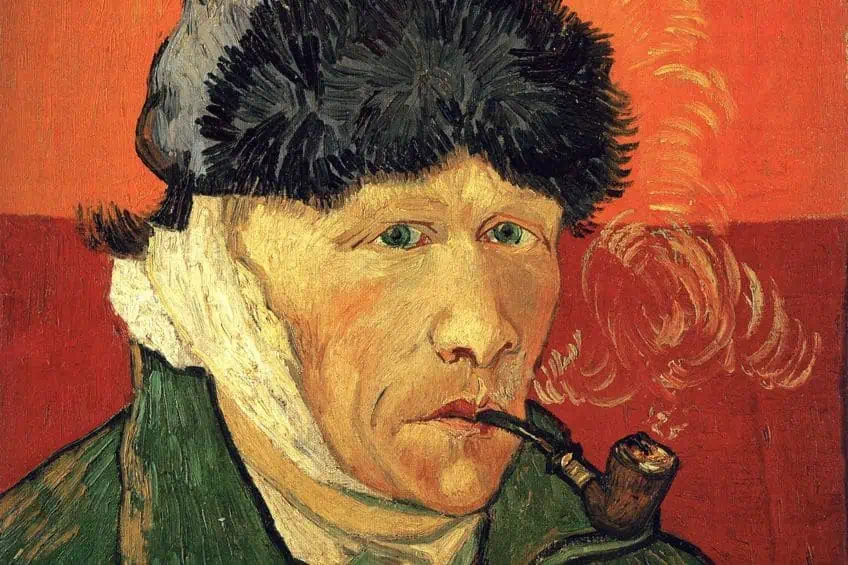Why Did Van Gogh Cut Off His Ear? – The True Story
Vincent van Gogh was one of the most celebrated Dutch post-Impressionists of all time, whose unique art style was a product of his personal philosophy that defied traditional conventions in painting and representation. Aside from his unique art style, Van Gogh is also associated with the famous ear-cutting incident, which marked the beginning of mental health questions and concerns around artists and the societal structures that contribute to such events. What happened to Van Gogh’s ear? Which ear did Van Gogh cut off? And did the context of the time influence his decision? These are among the most pertinent questions about the incident that we will dive into below. Keep reading for more about the incident that took place on 23 December 1888!
Examining Pain Points in the Life of Vincent van Gogh
Who was the artist that cut off his own ear? And what caused him to do so? Vincent van Gogh has remained one of the most well-known Dutch post-Impressionist painters of the 19th century since he chopped off his ear. Before this mysterious incident, Van Gogh was not a name synonymous with fame and fortune. On the contrary, Van Gogh was known to be a humble painter who was dedicated to Christianity, lived a frugal lifestyle, and in the end, was classified as a “madman”.

Born Vincent Willem van Gogh, the young artist-to-be was born to a minister of a Dutch Reformed Church and took the name of his grandfather, who was a famous art dealer. From an early age, his mother encouraged him to draw and as such express himself freely through art. Van Gogh’s early drawings at a school in Tilburg reflected his strong opposition to academic teaching and focused on capturing the impression of objects as opposed to their likeness. It is speculated that his early depression was present in his art as a rebellion against what was expected of him in drawing class, and perhaps society itself. His experience was captured succinctly in his reflections on his youth, which he described as “austere, cold, and sterile”.
After a long-term reluctance to join a formal art institution, he enrolled at the Académie Royale des Beaux-Arts where he studied anatomy, perspective, and the basics of modeling. At one point, Van Gogh also proposed to his widowed cousin Cornelia “Kee” Vos-Stricker, who refused his offer on two separate occasions, even after he threatened to burn his hand over a fire and followed through. Van Gogh’s cousin and artist, who he greatly admired, Anton Mauve, encouraged him to pursue pastel, charcoal, and later watercolor and oil, the latter of which Van Gogh quickly adopted.
Unfortunately, the two fell out over a disagreement over drawing from plaster casts instead of live models and Van Gogh ended up in hospital for three weeks after contracting a sexually transmitted disease from his engagements with street models.
Van Gogh lost his father to a heart attack, which resulted in a number of his works relaying a somber mood with no vivid colors. During this period, Theo engaged frequently with Van Gogh in the sale of his paintings and his first exhibition in Paris until Van Gogh was accused of rape. After moving to Antwerp, Van Gogh’s financial situation took a turn for the worse. He spent most of his time studying color theory while analyzing the work of Peter Paul Rubens and soon fell into alcoholism and was hospitalized for syphilis.
By the age of 33, Van Gogh had already faced immense strain on his mental health, with no access to psychologists, he had already experienced loss, ill health, abandonment, poverty, self-abandonment, and rejection. His early artistic career was not as successful as he hoped it would be and his struggles with romantic relationships and ongoing pressure from his parents only added to his mental burden. All major events were reflected strongly in his paintings, drawings, and erratic behavior formed by an unstable lifestyle, which seemed out of his control and possibly contributed to the later Van Gogh ear story at the Yellow House.
The Van Gogh Ear Story: The Eve of 23 December 1888
What happened to Van Gogh’s ear? To better understand the Van Gogh ear story, one needs to grasp the context leading up to the event. In the mid-1880s, Van Gogh moved in with his brother Theo in Montmartre, where his paintings began to take shape through vivid colors, still-lifes, Impressionistic painting styles, and Contemporary scenes of Parisian life.
Van Gogh relocated to Asnières where he gained the acquaintance of Paul Signac and befriended Paul Gauguin, whom he exchanged work with. By 1888, Van Gogh was already suffering from health issues brought on by excessive drinking and developed a smoker’s cough. He then moved to Arles with the hope of establishing an “art colony” and found himself enchanted by Arles’ culture and countryside. He signed a lease for a studio at the Yellow House at 2 Place Lamartine, which was a testament to his vision and solidified his plans to invite Paul Gauguin and build on their friendship to establish a collective of sorts.
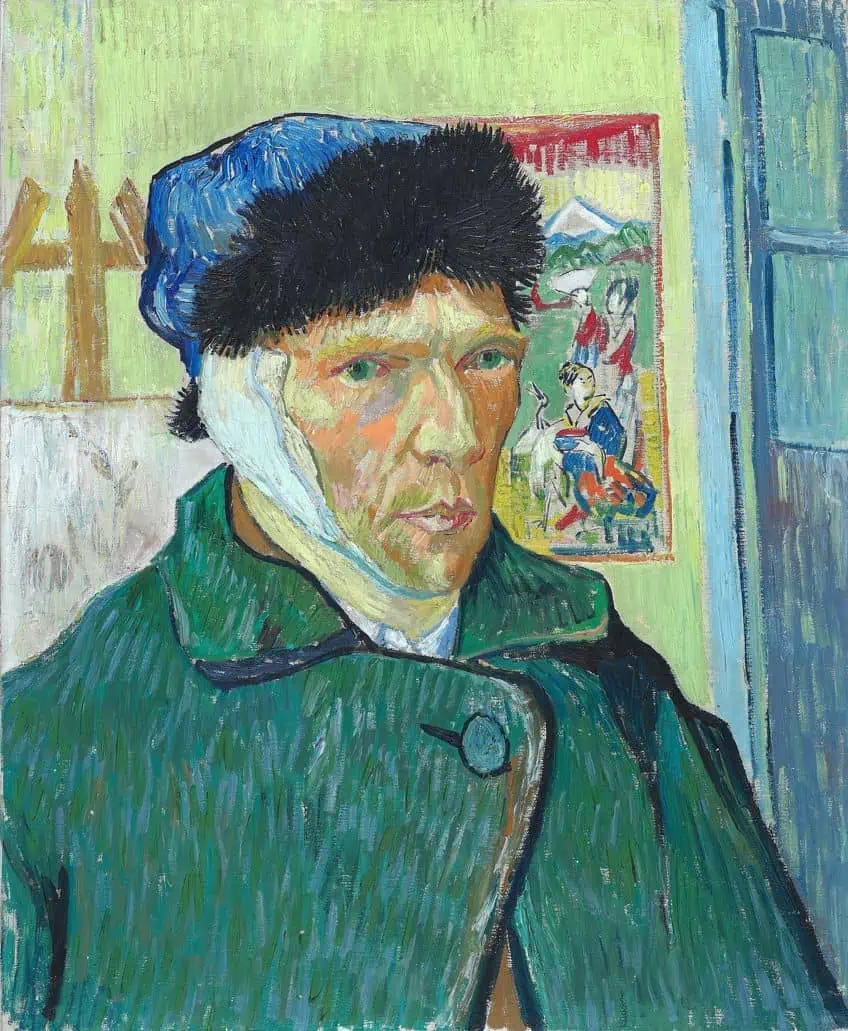
Gauguin spent around two years with Van Gogh, however, the relationship deteriorated due to their conflicting personalities. Van Gogh wished to learn from Gauguin but found him to be “domineering” and perhaps too “arrogant”, however, Van Gogh could not accept Gauguin’s personality and identity that he was different from the imagined version he looked up to. With the evident tension, Van Gogh developed a fear that Gauguin would leave him.
The next events that transpired remain disputed due to the speculation about why Van Gogh cut off his own ear. The relationship between Gauguin and Van Gogh was unclear, however, according to an account by Gauguin, there were several instances of physical violence. It had also been speculated that Theo and Van Gogh were accused of exploiting Gauguin financially and so Van Gogh was increasingly aware of Gauguin’s attitude or displeasure at the two and knew he would end up leaving.
In the days leading up to the ear-cutting incident, the two stayed in the Yellow House due to rain. Gauguin’s account also stated that Van Gogh followed him after he left for a brief walk with a razor in his hand. It was reported that Gauguin left for a hotel the same evening that Van Gogh cut off his ear.
Why did Van Gogh cut off his ear? And which ear did Van Gogh cut off? The majority of theories surrounding the ear-cutting incident involve speculation about Van Gogh’s mental state. The incident reportedly took place on 23 December 1888 after an altercation in the Yellow House. Van Gogh returned to his room where he allegedly heard voices or hallucinations, and then severed his ear, resulting in heavy bleeding. He then bandaged his wound and wrapped his severed ear in paper and delivered it to a cleaning woman, Gabrielle Berlatier, who was 18 years old and worked at the brothel that Van Gogh and Gauguin frequented. Berlatier was left traumatized by the event and fainted almost instantaneously.
Van Gogh was discovered unconscious by a policeman and later treated by a medical student called Félix Rey. Van Gogh’s ear could not be reattached and it was concluded that Van Gogh suffered an acute mental breakdown. When he regained consciousness, he was unable to recall the event and was diagnosed with acute mania and generalized delirium, sentencing him to hospital care. Gauguin sent notice to Theo who had just proposed to his partner Johanna.
Return to the Yellow House and the Asylum
Theo arrived in Arles on Christmas Day to find his brother semi-lucid and returned that evening. Despite Van Gogh continuously requesting Gauguin’s presence, Gauguin refused politely since he believed that his presence would worsen Van Gogh’s mental state. Gauguin left Arles and never returned, however, still wrote to Van Gogh. After he recovered, Van Gogh returned to the Yellow House where he continued to suffer from hallucinations and fears of being poisoned. By March of 1889, police closed his studio after 30 locals petitioned that he was mad, which resulted in Van Gogh’s readmission to the hospital. Van Gogh then moved to an asylum in Saint-Rémy-de-Provence where he wrote to his brother describing his mood swings as ranging between an “indescribable anguish” and “moments when the veil of time (and fatality of circumstances) seemed to be torn apart”.

Van Gogh was allocated two cells with barred windows, one of which he used as a studio at the Saint-Paul-de-Mausole asylum. It was at the asylum where his unique style emerged and was characterized by vivid dreamy swirls and landscapes. His subjects were determined by his limited movements since he was always supervised during his walks. In 1890, Van Gogh relapsed and began painting scenes from memory. He also requested that his mother send him his old drawings from childhood so that he could rework them as paintings. In the same year, his work was also described as “genius” and he was invited by the Les XX collective to exhibit work at their annual exhibition. Claude Monet also admired his work, stating that it was the best out of the whole Artistes Indépendants show.
The Psyche Behind the Severed Ear
Given that Paul Gauguin’s statements on the event leading up to Van Gogh’s act of self-mutilation were given 15 years later, there have been many other theories surrounding the true nature of the event and what must have transpired in Van Gogh’s mind to cause him to cut off his own ear. It was also reported that Van Gogh experienced a period of “eye strain”, which caused him to remain indoors in the days leading up to the incident. Gauguin and Van Gogh undoubtedly shared a close bond, which was destroyed due to their conflicting personalities. Towards the end of his life, Van Gogh wrote to his brother expressing his loneliness, which was also reflected in his paintings that were better able to express what he could not put into words.
On 27 July 1890, Van Gogh shot himself in his chest and died 30 hours later. It was speculated that he shot himself in a wheatfield or barn while painting. He was treated by two doctors who were unable to remove the bullet and left him in his room to smoke his pipe for the few hours he had left. Theo arrived on the scene the next morning, however, his wounds became infected and his condition worsened.
Van Gogh passed in the early morning of July 19th with his last words stating that his “sadness will last forever”.
The reasons why Van Gogh cut off his ear were attributed to a buildup of traumatic events in his life, with the most powerful trigger being the end of his friendship with his hero, Paul Gauguin, followed by the fear that his brother Theo would not be as actively involved in his life following his recent engagement. Another trigger was possible, that amidst these events that sparked his abandonment wounds, he was also presented with the loss of his sense of self in a society where the number of people who called him a madman overpowered the opinions of the few who knew him.
The multitude of questions on Van Gogh’s mental health inspired a 2016 exhibition called On the Verge of Insanity, which featured a bioengineered replica of Van Gogh’s severed ear, which was crafted using genetic material from Van Gogh’s great-great-great nephew. Van Gogh’s hallucinations in the Yellow House were attributed to his withdrawal from alcohol and attempt to “get clean”, which only worsened his heightened state of fear and need for intense numbing.
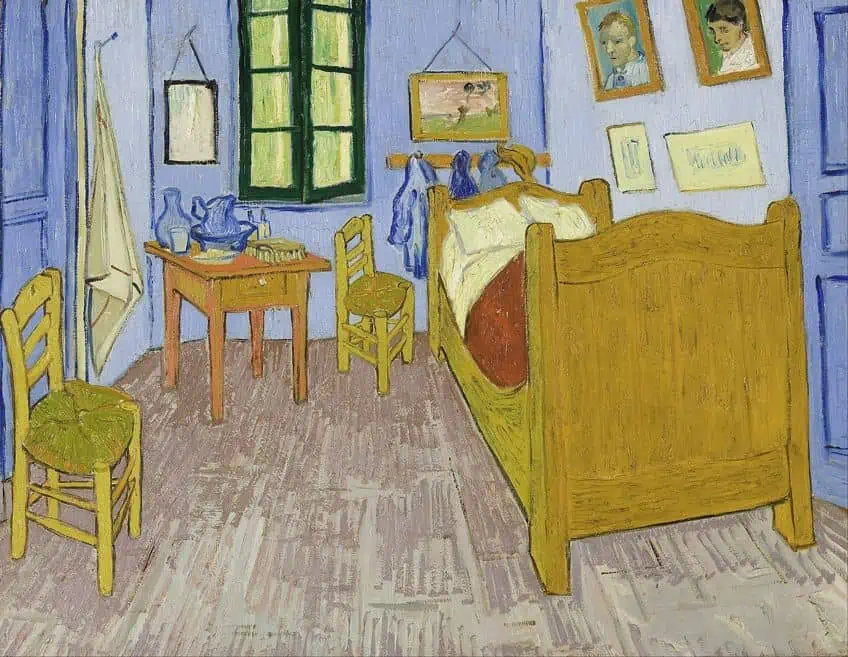
Van Gogh’s letters were also disproved as reliable sources for theorizing his health status since he often wrote them to reassure his loved ones. However, it was derived from the letters that he possibly suffered from a severe borderline personality disorder. In addition to the alcohol withdrawal, his ear-cutting incident was also spurred on by temporal lobe epilepsy, which he was officially diagnosed with under his doctor at the asylum, Théophile Peyron.
Theo’s accounts of his brother also potentially place Van Gogh as bipolar, with his statements alluding to his brother’s “dueling personalities”, described as ranging between “unfeeling” and yet “sensitive and gentle”. Modern theories speculate that Van Gogh may have suffered from Acute Intermittent Porphyria, also known as AIP syndrome in addition to an absinthe addiction, which was common in French art circles and would not have been picked up by doctors as an addiction.
Other speculations have been narrowed down to absinthe poisoning, sunstroke, and aural hallucinations in the day leading up to the ear-cutting incident.
In 2016, art historian Bernadette Murphy published a book called Van Gogh’s Ear, which details her six-year research and conclusions on the self-harm attempt by Van Gogh. An alternative theory suggests that Gauguin was the one who mutilated Van Gogh with a sword, however, there was no conclusive evidence of this other than accounts that Gauguin was an accomplished fencer.
Details Behind the Severed Ear Incident
The question “what part of the ear did Van Gogh cut off?” And “Which ear did Van Gogh cut off?” have convoluted yet simple answers. For years, the question of which part of the ear Van Gogh severed remained controversial due to the statement that Paul Signac gave that his lobe was slashed. Bernadette Murphy uncovered that a letter by Félix Rey was the only irrefutable proof that Van Gogh did cut off his entire ear since the drawing of Van Gogh’s wound showed a clean incision around the base of the artist’s ear, which left only a sliver of lobe flesh.
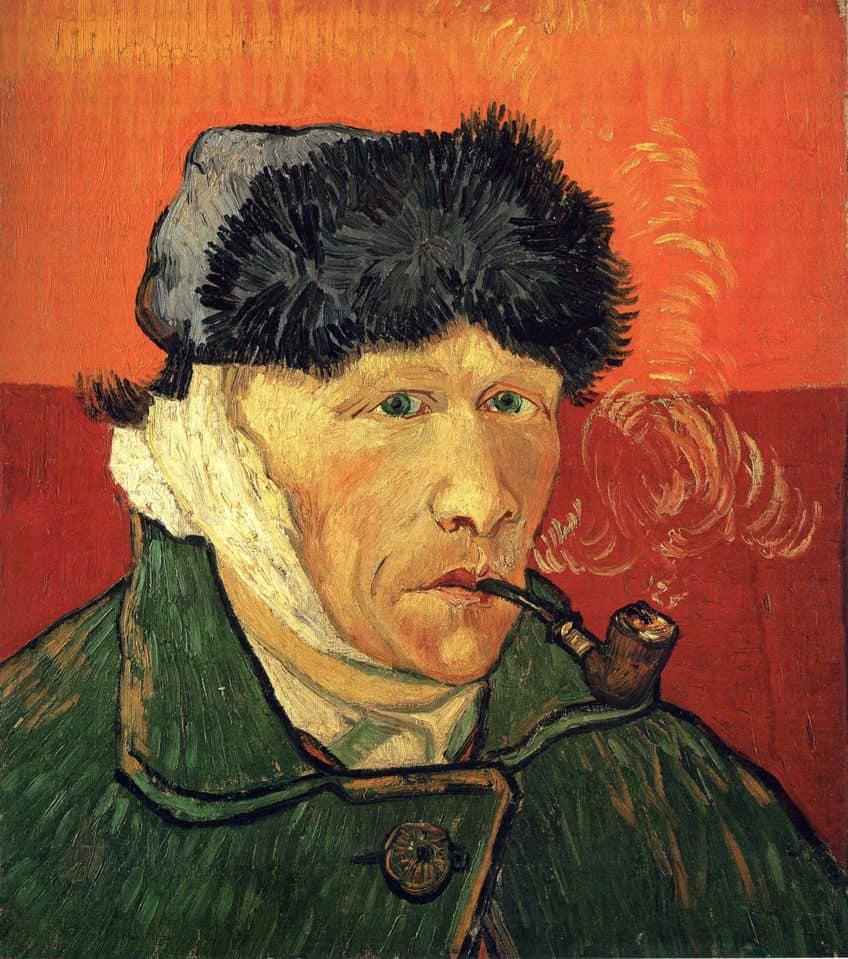
Murphy also uncovered that the petition to evict Van Gogh from the Yellow House was more of an act of discrimination since a few signatures on the petition were from individuals who did not even reside in Arles. It was theorized that Van Gogh was under the belief that more people wanted him gone than those who were involved, which only worsened his anxiety and self-rejection, possibly even causing him to have no choice but to lash out at himself. The question “Which ear did Van Gogh cut off?” is less discussed as a topic of importance, however, it is stated that Van Gogh cut off his left ear, which can be seen in Self-Portrait with Bandaged Ear (1889), which he painted using a mirror. The reasons for this include his attempt to possibly stop the aural hallucinations he experienced due to withdrawal from alcohol.
Mental Health Care in the 19th Century
Attempting to understand the mental state of an artist from the 19th century whose act of self-mutilation and suicide is no simple task. Gaining an understanding of the context of the 19th century in terms of its societal outlook on mental health, artists, and the medical capability of the period also sheds some light on the state of Van Gogh, who ultimately became an icon of “the struggling artist” stereotype and an example of prejudice against artists who suffer from mental health issues. One can begin to understand that the events that transpired around Van Gogh’s ear-cutting incident were perhaps triggers to his suicide that resulted in his act of self-mutilation becoming a sign, unignorable, of his later demise and the lengths to which he was capable of going to.
Self-harm and suicide were no easy topics for anyone to comprehend in the 19th century. The small and severe signs of mental health issues that Van Gogh displayed were more than likely to be interpreted as signs of madness and disillusionment, which were further worsened by the lack of restrictions around substances such as absinthe, and the pressure of societal expectations for a man (or artist) to be successful, get married, and be accepted as a functioning member of European society.
People who were diagnosed as “mad” were usually locked up, isolated, and subject to inhumane conditions that removed them from society to “reform” their behavior, however, in most cases, this generated the opposite effect on severely ill individuals who would often realize that society thought of them as the issue.
Forms of treatment for those who suffered from melancholy included drugs and methods such as massages, baths, arsenic, strophanthin, ferrous iodide, ergot, and cinchona. In America, methods such as bloodletting and purgatives were employed to treat mentally ill persons as well as “moral treatment”. In the late 19th century, there were well over 100 mental asylums in France alone, which is an indication of the rise in mentally ill individuals and a reflection of the state of society.
One can only speculate the impact that societal viewpoints of mentally ill persons and their available treatment options had on Vincent van Gogh and his perception of self. It is clear from reviewing his life history, and career, that his efforts in persevering in succeeding in his career as well as attempting numerous times to fit into specific societal molds, was what worsened his condition. Van Gogh was raised in an incredibly religious household in a society that privileged moral values while contradicting them.
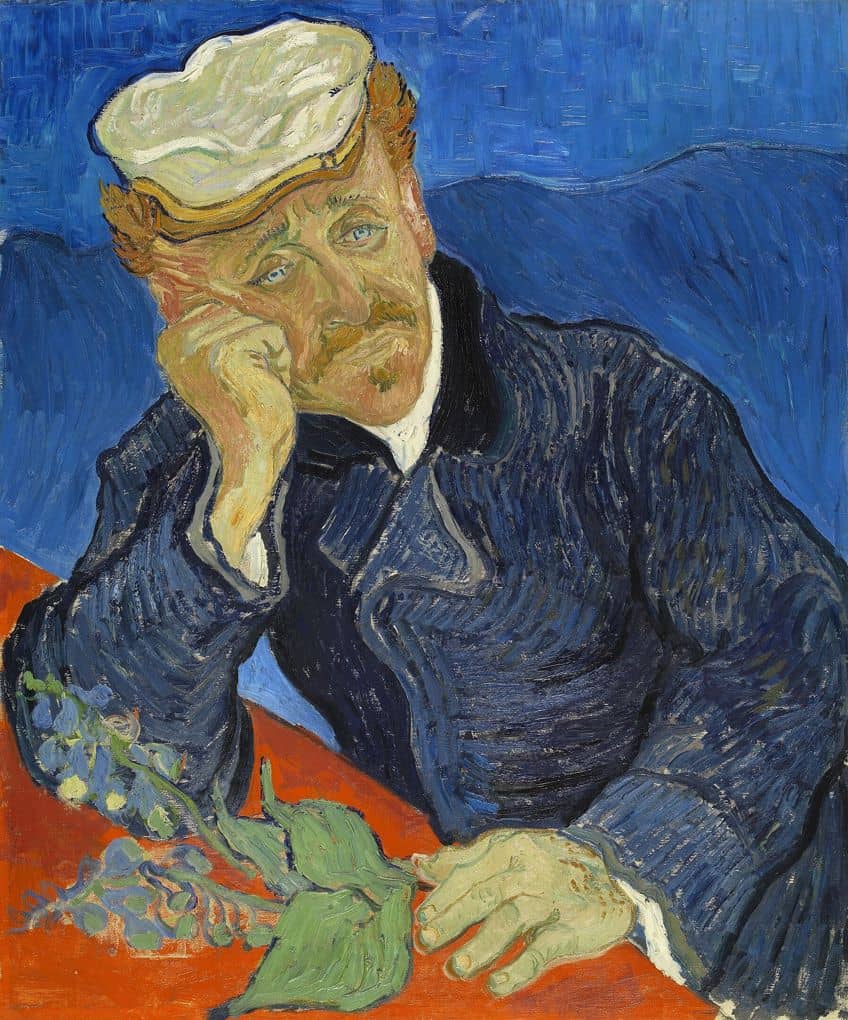
It is evident that the resources available at the time to help Van Gogh was inadequate and one might perhaps wonder that if his mental health were better, might he have painted differently? Might we have never got to see iconic paintings such as Sunflowers (1887) and The Starry Night (1889)? Toward the latter stage of his career, Van Gogh strived toward creating an ideal world for himself in his attempts to connect with Gauguin through friendship, yet discovered that his reality was no more than the label of a madman, reinforced to him by his abandonment wounds, the petition against his stay at the Yellow House, the fear of losing his brother’s support and presence, the lifelong pressure to appease his parents, and his sense of self, through which he managed to preserve through self-portraits, over 900 paintings, and a severed ear.
19th-century society condemned severely depressed and mentally ill people to a lifestyle of isolation and supervision as if society itself did not create their condition. Despite his struggles with alcoholism, community prejudices, and forming stable relationships, Vincent van Gogh has much to teach one about the importance of learning about triggers and the ways that social structures can have an impact on the delicate margins of mental health, whether it be the 19th or the 21st century.
Frequently Asked Questions
Which Ear Did Van Gogh Cut Off?
Vincent van Gogh cut off his left ear on the evening of 23 December 1888 with an open razor blade. It is concluded that he severed his left ear, as seen in his self-portraits following the incident.
Why Did Van Gogh Cut Off His Ear?
Vincent van Gogh cut off his ear due to multiple speculative reasons. These reasons include triggers, which affected Van Gogh’s mental state, such as his disintegrating friendship with close friend Paul Gauguin, his brother’s engagement, the communal pressure and prejudice against his mental health, and the influence of alcohol on his depressive state. His ear-cutting incident was initially attributed to a psychotic break, but current analyses suggest that the act of self-mutilation was caused by a series of cumulative emotional events coupled with intoxication from absinthe.
What Condition Did Van Gogh Suffer From?
It has been theorized that Vincent van Gogh suffered from conditions, not limited to one, such as severe bipolar personality disorder, severe depression, Acute Intermittent Porphyria, and had a confirmed diagnosis of temporal lobe epilepsy.
Liam Davis is an experienced art historian with demonstrated experience in the industry. After graduating from the Academy of Art History with a bachelor’s degree, Liam worked for many years as a copywriter for various art magazines and online art galleries. He also worked as an art curator for an art gallery in Illinois before working now as editor-in-chief for artfilemagazine.com. Liam’s passion is, aside from sculptures from the Roman and Greek periods, cave paintings, and neolithic art.
Learn more about Liam Davis and about us.
Cite this Article
Liam, Davis, “Why Did Van Gogh Cut Off His Ear? – The True Story.” artfilemagazine – Your Online Art Source. October 4, 2023. URL: https://artfilemagazine.com/why-did-van-gogh-cut-off-his-ear/
Davis, L. (2023, 4 October). Why Did Van Gogh Cut Off His Ear? – The True Story. artfilemagazine – Your Online Art Source. https://artfilemagazine.com/why-did-van-gogh-cut-off-his-ear/
Davis, Liam. “Why Did Van Gogh Cut Off His Ear? – The True Story.” artfilemagazine – Your Online Art Source, October 4, 2023. https://artfilemagazine.com/why-did-van-gogh-cut-off-his-ear/.


